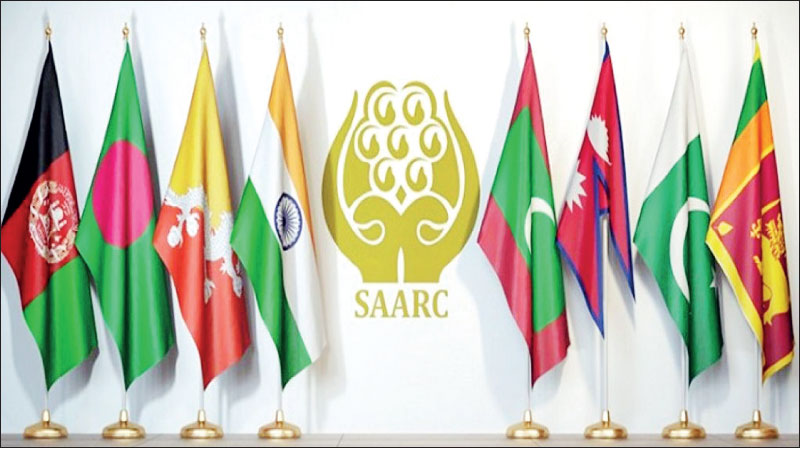Friday Apr 04, 2025
Friday Apr 04, 2025
Friday, 20 May 2022 00:40 - - {{hitsCtrl.values.hits}}

SAARC can play a more active role especially now as South Asia is on the brink of collapse
 South Asia is facing its worst crisis in recent decades. Pakistan is facing a severe economic and political crisis. Sri Lanka is facing its worst economic and political crisis since independence. Nepal is facing a severe economic crisis. Afghanistan too is facing a massive economic crisis and the people are on the brink of starvation. Only India, Bangladesh and Maldives remain stable but India is also facing an inflation crisis so this begs the question of what is SAARC doing or where are they?
South Asia is facing its worst crisis in recent decades. Pakistan is facing a severe economic and political crisis. Sri Lanka is facing its worst economic and political crisis since independence. Nepal is facing a severe economic crisis. Afghanistan too is facing a massive economic crisis and the people are on the brink of starvation. Only India, Bangladesh and Maldives remain stable but India is also facing an inflation crisis so this begs the question of what is SAARC doing or where are they?
The South Asian Association for Regional Cooperation is the regional intergovernmental organisation and geopolitical union of states in South Asia and was founded in December 1985 in Dhaka, Bangladesh to achieve regional reconciliation. Its member states are Afghanistan, Bangladesh, Bhutan, India, Maldives, Nepal, Pakistan, and Sri Lanka.
Pakistan crisis
Pakistan’s economy is in a downward stream and is on the verge of bankruptcy. The new Finance Minister has stated that currency outflow curb measures will be introduced soon to stop informal channels. The Pakistani Rupee has been losing value at a steady pace. The average inflation rate between July 2021 and January 2022 stood at 10.26% and is expected to cross 15% by summer and with UN’s Food and Agriculture Organisation showing record-high food prices through its Food Price Index.
Pakistan is also facing a severe balance of payment crisis as the State Bank of Pakistan’s reserves are now at a dangerous level of only $ 11 billion which is not sufficient to even cover one and a half months of imports. This comes in the backdrop of political instability with Imran Khan being ousted as Prime Minister via a no-confidence motion. There were allegations of foreign intervention that have yet to be verified.
Sri Lanka crisis
Sri Lanka is going through the worst economic and political crisis since independence and is yet in a critical stage. The economy has been severely affected as a result of mismanagement by the Gotabaya and Mahinda Rajapaksa led government and this has resulted in severe food, medicine, fuel and gas shortages. The Sri Lankan Rupee plunged severely against the Dollar and inflation was at 29.8% in April. Sri Lanka has to pay $ 7 billion in foreign debt this year and has foreign reserves of only $ 50 million at present. Sri Lanka’s first default of foreign debt is also likely this week.
The political instability is equally worse with the former Prime Minister Mahinda Rajapaksa having to flee for safety as his residences were set on fire during violent protests after his supporters assaulted peaceful protestors near Temple Trees and Galle Face Green. Several houses of Ministers and MPs were torched. The New Prime Minister is trying to form a government with several loose factions demanding their needs. The protests continue and the people queuing up for fuel and gas are getting longer by the day.
Nepal crisis
Nepal has been going through an economic crisis and the government recently began curbing non-essential imports in an effort to ease the dwindling foreign currency reserves. Nepal has been seeing an unprecedented increase in food prices. Nepal, with a population of around 29 million, is a nation landlocked between India and China. It relies heavily on its southern neighbour India for imports of almost all of its essential supplies, including fuel and inflation is standing at 20%.Government debt in Nepal has risen to more than 43% of its GDP. According to the country’s central bank, Nepal Rastra Bank, foreign currency reserves fell by more than 16% to 1.17 trillion Nepali rupees ($ 9.59 b; £ 7.36 b) in the seven months to the middle of February. Expatriate earnings sent to Nepal by people working abroad fell by almost 5%. Nepal’s biggest revenue is remittances and $ 8 billion was sent by Nepalis in 2020. As a result of COVID, more than 1.2 million people fell below the poverty line as people lost their jobs and a sudden rise in the prices of essential commodities.
Afghanistan crisis
Unemployment and poverty have taken over families in Afghanistan ever since the Taliban took power and many economists have warned of a major economic crisis in the country and have urged immediate steps to tackle the situation. In an IPC Acute Food Security Analysis report it says that nearly 20 million people of Afghanistan are living below the poverty line and this is mainly as a result of the economic crisis and drought in the country. The data was estimated to be between March 2022 and November 2022.
The political turmoil in the country has added to the woes of the Afghans as the Taliban government has increasingly become isolated by foreign countries and much-needed aid is being delayed and also a diplomatic raft with Pakistan is adding to the diplomatic crisis in the country.
Where is SAARC?
The real question is despite all of these occurrences in South Asia and with many countries going through severe economic and political crises, why has SAARC not issued any statement or appealed for a joint forum or fund to combat these crises? The EU for example is handling the situation in an exemplary way during the Russian-Ukrainian conflict and they acted swiftly and promptly by supporting Ukraine financially and diplomatically. SAARC can play a more active role especially now as South Asia is on the brink of collapse and it is about time for SAARC to act and work on some sort of mechanism which will help improve the lives of hundreds of millions of people in South Asia.
(The writer is an International Consultant and Visiting Lecturer at the University of Sri Jayewardenepura.)
Discover Kapruka, the leading online shopping platform in Sri Lanka, where you can conveniently send Gifts and Flowers to your loved ones for any event including Valentine ’s Day. Explore a wide range of popular Shopping Categories on Kapruka, including Toys, Groceries, Electronics, Birthday Cakes, Fruits, Chocolates, Flower Bouquets, Clothing, Watches, Lingerie, Gift Sets and Jewellery. Also if you’re interested in selling with Kapruka, Partner Central by Kapruka is the best solution to start with. Moreover, through Kapruka Global Shop, you can also enjoy the convenience of purchasing products from renowned platforms like Amazon and eBay and have them delivered to Sri Lanka.
Discover Kapruka, the leading online shopping platform in Sri Lanka, where you can conveniently send Gifts and Flowers to your loved ones for any event including Valentine ’s Day. Explore a wide range of popular Shopping Categories on Kapruka, including Toys, Groceries, Electronics, Birthday Cakes, Fruits, Chocolates, Flower Bouquets, Clothing, Watches, Lingerie, Gift Sets and Jewellery. Also if you’re interested in selling with Kapruka, Partner Central by Kapruka is the best solution to start with. Moreover, through Kapruka Global Shop, you can also enjoy the convenience of purchasing products from renowned platforms like Amazon and eBay and have them delivered to Sri Lanka.